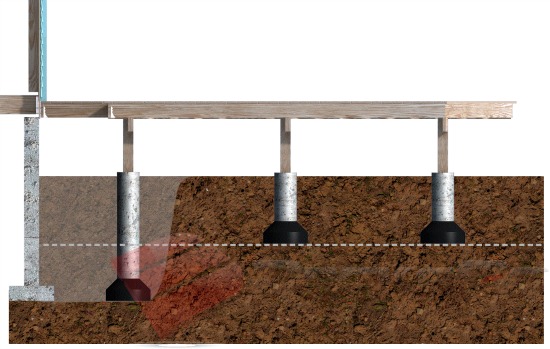Should I Pour My Deck Footings Now, For a Deck I'm Building Next Year?
by Artak
(Redmond, WA)
I am preparing to build a paver patio beside my house, in my garden. I am also planning to build an 8’ free-standing deck sometime next year. Since I will be digging below grade to install the pavers, I was wondering if I could also dig and pour the deck footings at the same time?
Is this is a good approach? Should I apply for a permit from the city for the deck now? Can the footings inspection happen as a single work? Or are there stages in the inspection process?
Editor's Comments
Your questions about how to plan your decking project and how city building inspections work are very common.Digging Deck Footings and Paver Patio at the Same Time: Is it a Good Idea?
It is a great idea to dig your deck footings now while you are already in the process of digging below grade to install your pavers. After all, why not get two birds with one stone?Here are a few things that you may want to keep in mind before you do so.
Applying for a Building Permit
The best answer would be to check with your local jurisdiction and their permit requirements. Every jurisdiction is a little different, however, in most cases you would need to apply for a building permit now to start digging your footings.If you plan to have your deck inspected later, it is best to open the permit process early to ensure that all aspects of you deck are up to code.
Deck Footing Inspection
To avoid any unexpected issues with building inspectors it is best to have your project inspected around the time you dig the footings.For example, the IRC states that footings must be 12" below grade or below the frost zone depending on what your local climate is like. This means you should have the inspector come by just after you have dug the holes for the footings/piers and prove the depth. Then you can go ahead and pour the cement.
When the deck is complete, the building inspector will then come back to ensure that the deck itself is built to code but you already proved the footings were done correctly. The permit remains open for as long at it takes until the rest of the project is complete.
Building a Free-Standing Deck: Things to Think About
You said you were planning to build an 8' high free-standing deck. Taking into consideration the height of the deck and the fact that it is not connected to the ledger, your deck will be prone to wobbling. An 8' high deck will in turn require significant bracing to avoid any potential wobbling.You may want to consider post to beam bracing, and depending on your project post to joist bracing.
Bracing your deck will make you deck more stable and less prone to wobbling there is one potentially large draw back, the higher your deck the more visible this bracing becomes. The braces may take away from the esthetic appeal of surrounding areas such as your paver patio. Have you thought of this?
Deck Footings in 5’ Disturbed Soil Zone
Another point you may want to consider is if the deck footings closest to your house will be in disturbed or undisturbed soil. Disturbed soil is the back filled soil around the house. Disturbed soil can be found in a zone of up to about 5' around the house. Undisturbed soil will be beyond that 5'zone.Do you know if your deck footings are in disturbed or undisturbed soil?
This largely depends on the age of your house. If your house is 0-3 years old, the soil is most likely disturbed because the soil has not had enough time to compact and settle. If your house is 10-20 years old, the soil is most likely undisturbed because the soil has had time to compact and settle. If your house is say 4-9 years old it is probably settled by then, however, to be sure you may want to get the soil checked by a soil engineer.
If the soil is classified as disturbed there are a few things you want to consider before digging your deck footings. If you adhere to the IRC building requirements and dig 12" or to the frost zone, your deck may tilt, experience uneven movement, or the footings may sink because the disturbed soil has not settled. This will be a lot of work to fix if tilting does occur.
To avoid movement the footing within 5' will need to be just as deep as the foundation of the house. This is also a lot of work, initially, however it will ensure that the deck is sturdy.
Did you find this article helpful? We'd love to hear about it! Share on your preferred social media platform on the left.


























